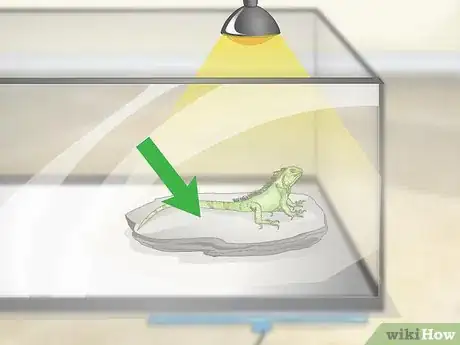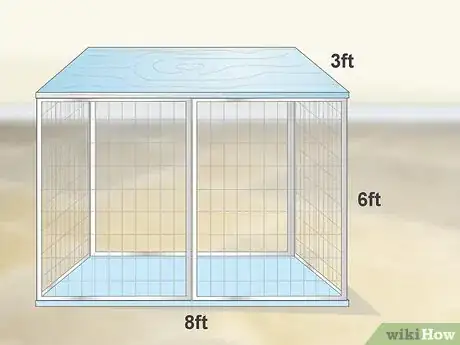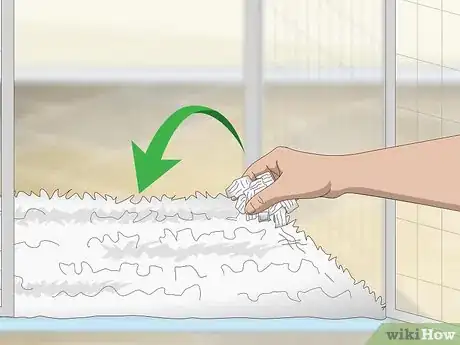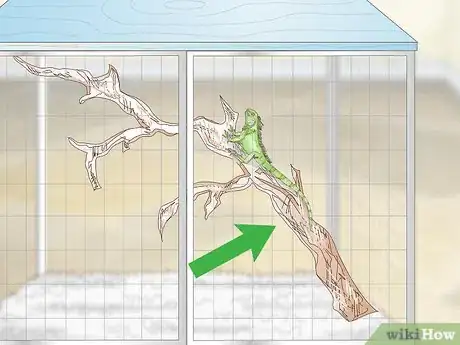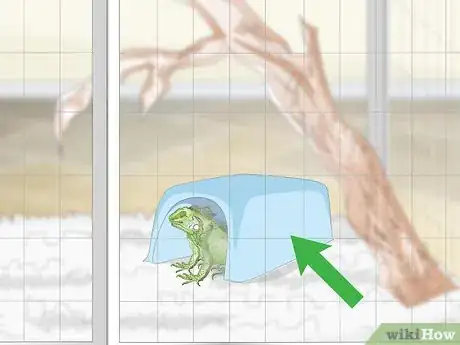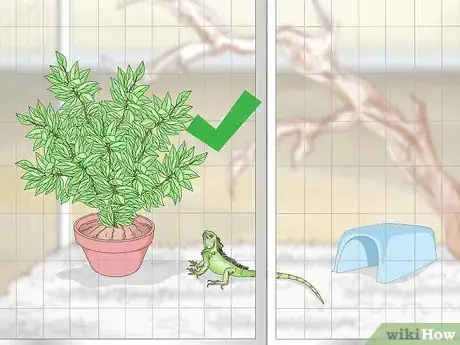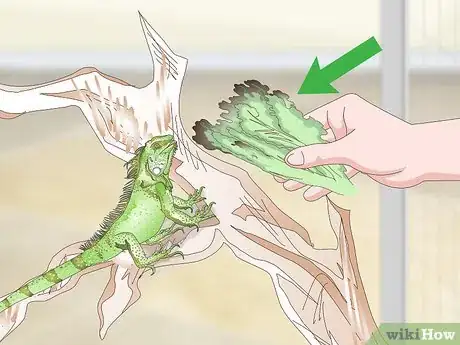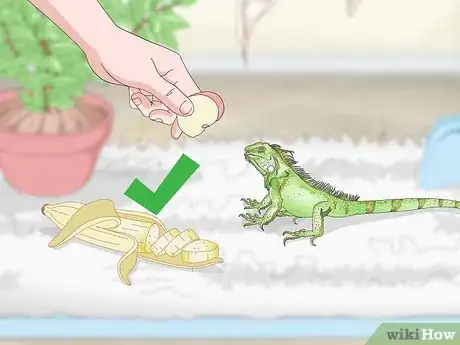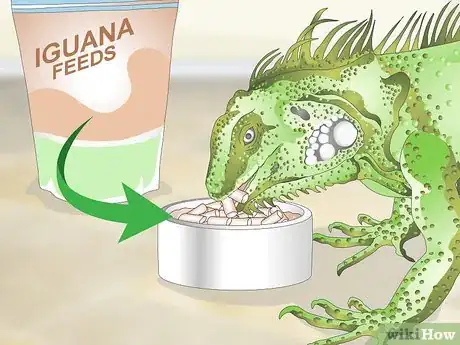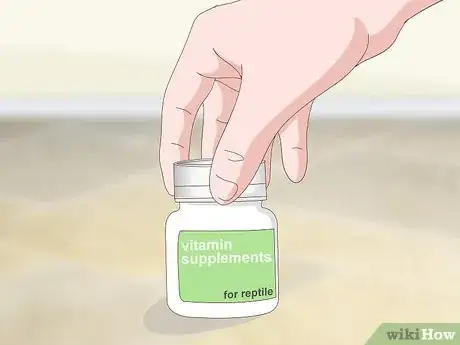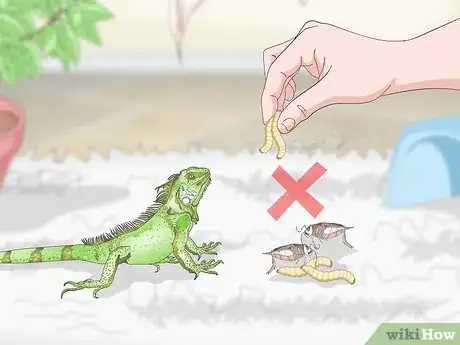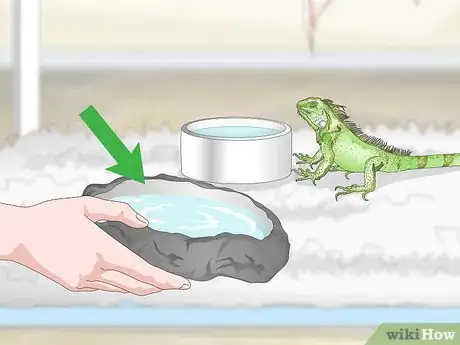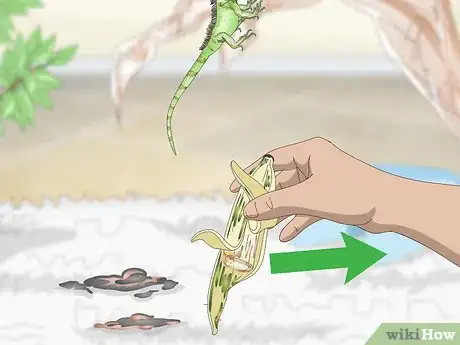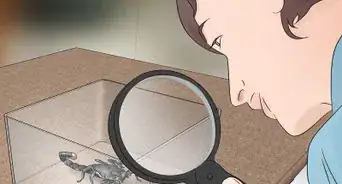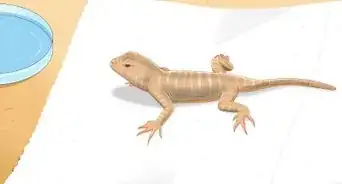This article was co-authored by Lauren Baker, DVM, PhD. Dr. Lauren Baker is a Veterinarian and Assistant Scientist at the University of Wisconsin-Madison. With over 10 years in veterinary medicine, she specializes in the concept of “one health,” which uses insights from veterinary medicine to help human medical research. She holds a Ph.D. in Comparative Biomedical Sciences, a Doctor of Veterinary Medicine, an MS in Comparative Biomedical Sciences, and a Bachelor’s degree in Psychology from the University of Wisconsin-Madison.
wikiHow marks an article as reader-approved once it receives enough positive feedback. This article received 15 testimonials and 95% of readers who voted found it helpful, earning it our reader-approved status.
This article has been viewed 250,711 times.
Iguanas are interesting reptiles to keep as pets. Unfortunately, iguanas are not easy to care for and will die if not taken care of properly. This is because iguanas have a variety of unique environmental and dietary needs. However, by creating a good habitat and feeding your iguana properly, you'll make sure your iguana thrives in its new home.
Steps
Creating the Right Climate
-
1Provide your iguana with lots of light. To thrive, iguanas need access to certain types of light. Most importantly, iguanas need ultralight light that is in the UVB spectrum. Without this sort of light, your iguana could suffer from a deficiency of vitamin D, be unable to absorb calcium, and have other health problems.
- Purchase UVB light bulbs that are specifically labelled for reptiles. Those made for reef tanks and plants don't provide enough UVB rays for your iguana. Make sure your lizard breed naturally adapted to this temperature.
- While UVB light should reach the entire habitat, make sure to place a light 12 to 18 inches (30 to 46 cm) above the iguana’s basking area.[1]
-
2Install a heat source for your iguana. Since most climates are cooler than environments where iguanas thrive, you’ll need to install a source of heat in your iguana’s habitat. This is important, as your iguana will not thrive if it is too cold.
- The coolest area of your iguana’s habitat should be between 75 and 80 degrees Fahrenheit (24 to 27 degrees Celsius).
- Keep the “basking area” between 95 and 100 degrees Fahrenheit (35 to 38 degrees Celsius).[2]
Advertisement -
3Install thermostats in the habitat. Place a thermostat in the middle and on the edge of the habitat. This way, you’ll be able to monitor the temperature in different parts of the habitat. Ultimately, this will help you make sure that the temperature and climate is right for your iguana.[3]
-
4Create a basking area. The basking area is an area of your iguana’s habitat where your iguana can enjoy heat and light. This area is fundamental to making your iguana happy. Without a basking area, your cage won’t simulate the iguana’s natural environment. Basking areas should have:[4]
- A large flat area for your iguana to lay.
- Direct light from a UVB light.
- A close proximity to a heat rock or another source of direct heat.
Outfitting the Habitat
-
1Purchase a large cage. Use a cage at least 8 feet by 3 feet by 6 feet (2.4 meters by .9 meters by 1.8 meters). As a rule, the larger the cage, the better. Without enough room, your iguana won’t be able to thrive and may wind up sick or depressed.[5]
- Wire cages are suitable if you live in an area that is consistently hot and humid. Otherwise, you will need a large glass tank or enclosure to make sure you can maintain your iguana's environmental conditions.[6]
-
2Spread substrate across the bottom of the habitat. After you pick your cage or enclosure, place substrate across the bottom of it. Use specially designed reptile carpet or flat or shredded newspaper.
- Avoid bark, woodchips, treated wood, or plastic.[7]
-
3Provide things for your iguana to climb. Because iguanas live in heavily wooded areas, your iguana will need lots of space and different types of things to climb on. Do this by placing a variety of large branches or specially designed platforms in the habitat. In addition, provide a variety of rocks for the iguana to climb on.[8]
- Make sure any branches or structures you place in the habitat are large and strong enough to support the iguana.
- Provide ramps for your iguana to climb to different levels of its habitat.
- Opt for smooth/flat rocks that your iguana can comfortably lay on.
-
4Create a hiding area. A box or cave-like area will allow your iguana to hide when it feels threatened or scared. Ultimately, a hiding area is an important part of any iguana habit. Without one, your iguana will feel vulnerable and may not thrive.[9]
- Place a small wooden box under some rocks.
-
5Place small plants in the habitat. Small plants will help transform your iguana’s habitat into a more interesting environment that better simulates the wild. Depending on the plants you place, your iguana may eat them or hide in them. Some plants to include are:
- Acacia
- Aloe
- Bamboo
- Thistle
- Jade plant
- Dandelion[10]
Feeding Your Iguana
-
1Give your iguana vegetables. Iguanas need greens and enjoy chopped veggies as healthy treats. Some appropriate greens include collards, mustard, dandelion, or turnip greens. In addition, your iguana will eat kale and different types of lettuce. Chopped veggie choices can include broccoli, bok choy, green beans, and squash. Ultimately, your iguana will spend a lot of time consuming vegetables.[11]
- Most lettuces, like iceberg and hearts of romaine, won’t provide enough vitamins and nutrients to sustain your iguana. Choose colorful lettuces that have more nutritional value.[12]
-
2Provide your iguana with fruits. In addition to leafy vegetables, your iguana will enjoy snacking on and eating a variety of fruits. Some good fruits to give your iguana include strawberries, blueberries, bananas, apples, cantaloupe. Ultimately, most berries and melons will make a good addition to your iguana’s diet.[13]
-
3Give your iguana commercially formulated iguana food. Iguana food is often in dry pellet form. Mix iguana food with fruits and vegetables in a fruit bowl or serve them separately. Many vets recommend wetting them slightly before giving them to your iguana, as this will make it easier for your iguana to eat. Remember, though, give store-bought food only as a supplement to fruits and vegetables.[14]
- Follow the directions on the product you purchase.
-
4Buy reptile vitamin supplements. Many iguanas don’t get all the nutrition they need in captivity. Because of this, your iguana may benefit from reptile vitamin supplements. These supplements come as powder and can be mixed with your iguana's food. They provide vitamins and minerals like calcium and vitamin D3, which are critical to your iguana’s health.[15]
-
5Avoid relying on insects. Iguanas are herbivores and don’t really eat meat in the wild. As a result, avoid providing them insects like crickets and mealworms that other reptiles often eat. Ultimately, too much protein could hurt your iguana.[16]
-
6Place several large water bowls in your iguana’s habitat. While your iguana will get most of the water it needs from its food, you should also provide several water bowls in its habitat. This way, your iguana will have access to a lot of clean and fresh water if it is thirsty. In addition, providing water bowls will help increase the humidity level of your iguana’s habitat.[17]
Avoiding Common Problems
-
1Do not house multiple iguanas together. Generally, avoid housing multiple iguanas in the same cage. If you house iguanas together, they could get into a fight and injure each other.
- You can house multiple iguanas in the same room or area as long as they are in separate cages.
- If you are for some reason considering placing more than one iguana in a single cage, talk to your vet first.
-
2Wash your iguana’s food and water bowl. Wash your iguana’s food bowls before placing new food in them. In addition, clean your iguana’s water bowls daily. To clean their food and water bowls, use warm water with a light dish detergent.[18]
-
3Clean the habitat regularly. To ensure the health and wellness of your iguana, you’ll need to clean various parts of the habitat daily. Remove spoiled food and other waste daily. Remove soiled substrate every week or so. In addition, remove broken parts of your iguana’s habitat, like branches.[19]
Expert Q&A
Did you know you can get expert answers for this article?
Unlock expert answers by supporting wikiHow
-
QuestionI have a pet cat that likes being around my room. I would have my Iguana in my room, so would my cat be a bother to the Iguana?
 Lauren Baker, DVM, PhDDr. Lauren Baker is a Veterinarian and Assistant Scientist at the University of Wisconsin-Madison. With over 10 years in veterinary medicine, she specializes in the concept of “one health,” which uses insights from veterinary medicine to help human medical research. She holds a Ph.D. in Comparative Biomedical Sciences, a Doctor of Veterinary Medicine, an MS in Comparative Biomedical Sciences, and a Bachelor’s degree in Psychology from the University of Wisconsin-Madison.
Lauren Baker, DVM, PhDDr. Lauren Baker is a Veterinarian and Assistant Scientist at the University of Wisconsin-Madison. With over 10 years in veterinary medicine, she specializes in the concept of “one health,” which uses insights from veterinary medicine to help human medical research. She holds a Ph.D. in Comparative Biomedical Sciences, a Doctor of Veterinary Medicine, an MS in Comparative Biomedical Sciences, and a Bachelor’s degree in Psychology from the University of Wisconsin-Madison.
Veterinarian
-
QuestionHow can I tell what sex my iguana is?
 Lauren Baker, DVM, PhDDr. Lauren Baker is a Veterinarian and Assistant Scientist at the University of Wisconsin-Madison. With over 10 years in veterinary medicine, she specializes in the concept of “one health,” which uses insights from veterinary medicine to help human medical research. She holds a Ph.D. in Comparative Biomedical Sciences, a Doctor of Veterinary Medicine, an MS in Comparative Biomedical Sciences, and a Bachelor’s degree in Psychology from the University of Wisconsin-Madison.
Lauren Baker, DVM, PhDDr. Lauren Baker is a Veterinarian and Assistant Scientist at the University of Wisconsin-Madison. With over 10 years in veterinary medicine, she specializes in the concept of “one health,” which uses insights from veterinary medicine to help human medical research. She holds a Ph.D. in Comparative Biomedical Sciences, a Doctor of Veterinary Medicine, an MS in Comparative Biomedical Sciences, and a Bachelor’s degree in Psychology from the University of Wisconsin-Madison.
Veterinarian
Things You'll Need
- Escape-proof iguana home that is of an adequate size
- U.V.B. light
- Heat Lamp
- Climbing structure to allow iguana to climb
- Proper Food
- Hide box for smaller iguanas
- Time and money
References
- ↑ http://www.avianandexotic.com/care-sheets/reptiles/green-iguana-fact-page/
- ↑ http://www.avianandexotic.com/care-sheets/reptiles/green-iguana-fact-page/
- ↑ http://petiguanacare.org/care-sheet/
- ↑ http://www.avianandexotic.com/care-sheets/reptiles/green-iguana-fact-page/
- ↑ http://petiguanacare.org/care-sheet/
- ↑ http://www.anapsid.org/pdf/icfs.pdf
- ↑ http://www.avianandexotic.com/care-sheets/reptiles/green-iguana-fact-page/
- ↑ http://www.avianandexotic.com/care-sheets/reptiles/green-iguana-fact-page/
- ↑ http://petiguanacare.org/care-sheet/
- ↑ http://www.iguanaden.org/diet/nontoxic.htm
- ↑ http://www.anapsid.org/pdf/icfs.pdf
- ↑ http://petiguanacare.org/care-sheet/
- ↑ http://petiguanacare.org/care-sheet/
- ↑ https://petiguanacare.org/food-diet/
- ↑ https://petiguanacare.org/food-diet/
- ↑ https://petiguanacare.org/food-diet/
- ↑ https://petiguanacare.org/cage-habitat/
- ↑ https://petiguanacare.org/cage-habitat/
- ↑ https://petiguanacare.org/cage-habitat/
About This Article
To care for an iguana, feed it chopped turnips or collards, and fruits such as strawberries and bananas. Additionally, make sure you put several water bowls in the cage to help increase humidity and give your iguana plenty to drink. You'll also want to set up a basking area in its cage that includes light from a UVB bulb, warmth from a heat rock, and a flat space for it to lie down on. When you're setting up the cage, spread shredded newspaper throughout the cage and give your iguana branches to climb on. For tips on what to avoid when caring for an iguana, including why you shouldn't house 2 iguanas together, read on!



